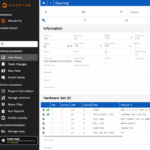 An AP article appeared in the news across Ohio over the weekend, reporting that on Friday, the Ohio Board of Building Standards gave final approval to rules allowing classroom barricade devices to be used in Ohio schools. But a disability rights group has weighed in at the 11th hour, pointing out that the devices do not comply with the ADA.
An AP article appeared in the news across Ohio over the weekend, reporting that on Friday, the Ohio Board of Building Standards gave final approval to rules allowing classroom barricade devices to be used in Ohio schools. But a disability rights group has weighed in at the 11th hour, pointing out that the devices do not comply with the ADA.
“The Americans with Disabilities Act requires that locks be usable by people with disabilities and doesn’t hold an exception for the devices, according to the Ohio Disability Rights Law and Policy Center.
That inconsistency may prevent some school employees from being able to use the devices and ‘has the potential to create an environment where they are discriminated against because of their inability to operate this device,’ said Michael Kirkman, the center’s executive director.”
Here’s where I’m confused…the disability rights group stated (I’m paraphrasing) that if a school chooses to purchase the devices, and a teacher has a disability that would prevent their use of the device, then the school has to make accommodations for that teacher (ie – supply a different type of lock). If these were existing devices – like knobs (instead of levers) in an existing building, maybe accommodating only the teacher with the disability would be acceptable. But these are new products which don’t meet the accessibility standards – why don’t the ADA requirements apply?
It could be because the new Ohio law requires devices which are installed temporarily, and does not allow a device that is permanently installed. If the device was permanently installed, the accessibility standards mandate operable hardware that requires no tight grasping, pinching, or twisting. Components that are not a permanently-attached part of the hardware, like keys, are not subject to the same requirements. I’m guessing the new language specifically requires “temporary” locking devices for this reason.
If a school decides to buy all new doorknobs for their school, and only buy a lever handle for the one classroom with a teacher who has a disability, in my opinion that would not meet the intent of the ADA. What makes it ok to do the same thing with classroom barricade devices? Given the many other concerns about these locking methods with regard to egress, fire protection, and the potential for unauthorized use with no means of authorized entry, I’m still perplexed.
You can read the AP article here.
Note: The Ohio rules require the temporary locking device to be removed with one operation if the school is not equipped with a sprinkler system, or with no more than two operations if the school is fully sprinklered. There are additional requirements which must be met if the devices are to be used. There is more information here, and the final rules are available here.
You need to login or register to bookmark/favorite this content.





What about a disabled student that may have to use the device??
I think the use of these devices, and the fact that the Ohio code change doesn’t address accessibility, opens schools up to a complaint based on section 504 of the Rehabilitation Act of 1973. http://www2.ed.gov/about/offices/list/ocr/504faq.html
– Lori
Why oh why do they want to spend money on Rube Goldberg devices instead of locks that work?
And how long will “temporary” last?
I’m with you on this one Lori, perplexed that is. I don’t understand why people can’t comprehend how dangerous these makeshift garage inventions are. As a highly credentialed member of an industry that has invented, specified, provided and installed doors and hardware for decades, I am insulted that our products and advice are ignored. Not that I am giving seminars myself, but I know many others are. Our industry continually changes and creates new hardware items to fill the current code requirements. Although a lot of hardware changes were necessitated by tragedies, if they weren’t then utilized [exit devices for one] there would be even more tragic events. Cost effective measures should not trump correct measures for life safety and security.
Lori, are more informed school districts changing locksets to “security classroom” function (which meet code requirements, ADA and allow authorized unlocking)?
Do these barricade devices cost less?
Or do schools see these devices as more secure because intruders might bust-open a locked door?
Hi Karl –
Many school districts use classroom security function locks. Some have gone to office function locks, which are still code-compliant but can be locked by an unauthorized person. There was a reason that classroom locks, and then classroom security locks were developed – because kids used to lock the teacher out. The possible ramifications of allowing unauthorized locking seem much more serious today, but at least someone with a key could enter the room.
Classroom barricade devices typically cost between $50 and $200, so yes – they cost less than a Grade 1 lockset. They can also be installed by the maintenance dept., rather than dealing with existing preps and installation, plus coordinating the keying of new locksets. Price and ease of procurement is typically the biggest motivating factor for schools – so much so that they are willing to overlook the negatives. In addition to the egress, fire protection, and accessibility problems, the fact that emergency responders and school staff can not enter the room when a classroom barricade device is in place, is a major safety risk.
Some schools are also concerned that with a traditional lock, the intruder could break the glass in the door or sidelight and reach through to turn the lever. A classroom barricade device could be installed out of reach to prevent that from happening, but then it would also be out of the allowable reach range for operable hardware. There are inexpensive security films that can be applied to the glazing to delay access through the glass.
– Lori
Unfortunately, this is not the first time I have observed the disregarding of the disabled in a “plan.” I have had several calls from schools and police officers in the past few days. All of them were considering devices. About 90% said they wouldn’t buy them after we discussed the issues all the experts in the field (most of them didn’t even know about the original document from the Ohio Board of Building Standards!) have with them. Any time something is rushed, done in fear, and is the result of pandering, bad things happen. These are giving the bad guys a huge advantage that they would never would have possessed had we taken a hard, measured look at the actual problem.
Hello I am the Director of Maintenance of Mt.Vernon City School in Ohio,I thlnk that we should be sure that ALL people should be able to barrcaide with 1 easy motion and be able to also egress with 1 motion which is why I have developed O.M.E One motion egress this device allows you to use the ADA handle that all public building should have. I’m know working on developing a way to get in from the hall for frist respouders and staff to get in if needed.please see video on youtube O.M.E one motion egress, and share your thoughts please
Hi Rick –
Is this the video? https://www.youtube.com/watch?v=SxNBEFYE57Q. I could post the video and get you some feedback from my readers, but embedding has been disabled for this video on Youtube.
– Lori
Sorry it has taken me so long to respond,But yes that is the correct video and it should be able to be embedded which would be great all feed back would be very helpfully.We really would like to get this product finish and made available before many more school waste money on devices that can’t and shouldn’t be used.We would love the chance to work with a lock set company’s innovations team to get that last piece of the puzzle, ingress from the hall.
Thank you
Rick
what is wrong with existing leverset? it can be locked from the inside with a teachers/staffers key
without ever having to open the door, A. N. D. it prevents the rugrats from making the teachers
day by locking her out !
some people have to complicate the simplest, existing things…